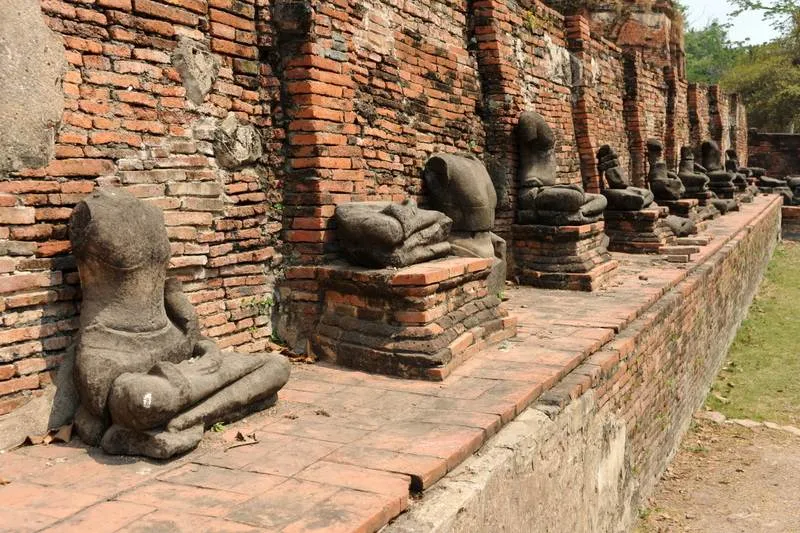
Despite their being a few other temples by a similar name, this one is Ayutthaya (Ayuthaya? Ayudthaya? Ayuthiya?) is perhaps the best known. The historical records are a bit contradictory, but the temple can be safely dated to the later 14th century. Thanks to its walking-distance proximity to the Grand Palace, it was one of the most important monasteries of the dynasty. Although it was the cosmopolitan capital for centuries, in 1767 the Burmese army razed the city, forced the citizens to move, and chopped the heads off Buddha statues.
A quick sidenote here: much of Ayutthaya reminds me of Gyeongju in southeast South Korea — an ancient capital, large at the time, conquered, but today has been partially to mostly restored. Not every building has, of course, though the historical documentation points out where things were. Both are UNESCO World Heritage sites as well — if you’ve enjoyed one, you’ll almost certainly enjoy the other. Development seems to have been slow and consciously done in each case — the franchised restaurants are only slowly making inroads in them both, and both offer a slower pace of life.

The ‘Indiana Jones’ feeling hit almost as soon as you walk in — you’re surrounded by ancient ruins, after all, and despite the signs saying not to climb up the buildings, there are very few barriers between you and them. This is well-traveled ground, however — and the hot sun makes you seek shade within a few minutes. There are ample places outside to grab some water, of course — no mainstream tourist destination would be complete without a number of souvenir stores. You won’t be thinking about them once you’re inside, though.

There’s plenty about the history of the temple online already, and what little there is on-site covers just the basics. This is one of the better records, although whoever designed their website needs to redesign it for today’s browsers…

One building under construction, or perhaps some restoration…?

The temple itself can take an hour or so to meander through, but your camera may not let you leave! There are seriously enough things to see and picture that the only thing making you leave is the desire to see more of the city.

Even with a head lopped off, can you still tell the nature of the Buddha?

The audio guide system seemed to be set up rather nicely, even if the signs looked a bit rusty. In retrospect, I wish I had given it a spin for 100 baht.

I haven’t seen a number on how many Buddha images were beheaded around the temple, but it wouldn’t be lower than several hundred.

Perhaps the most famous Buddha’s head in the temple — the sandstone head must have gotten entangled with the roots of the tree. There’s a small fence around it, and a number of people will pray to it.
Like a lot of temples, there are a couple different tracks to take. You could simply enjoy the beauty, or appreciate the history using the audio guide and other resources at your disposal before you go. It’s worth the visit, so long as you don’t mind the touristy nature of the mainstream destination.
Name: Wat Phra Mahathat
Address: Phra Nakhon Si Ayutthaya District, Phra Nakhon Si Ayutthaya (GPS: 14.356959,100.567485)
Directions: Your best option is a tuk-tuk here — if you have a decent pair of legs, you can likely rent a bike and pedal here from where the bus or train lets you off. It’s about 3 kilometers west from the train station.
Hours: 8am-6pm — open daily
Admission: 50 baht
Phone: 1672 (Tourism Authority of Thailand)
Website: http://www.sacred-destinations.com


